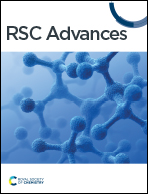Synthesis, characterization, molecular docking, and antimicrobial activities of dinuclear nickel(ii), palladium(ii), and platinum(iv) complexes†
Abstract
New nickel(II), palladium(II), and platinum(IV) complexes were synthesized by reacting the metal ions with benzidinedioxime in a 1 : 1 mole ratio. The CHN elemental analysis, spectroscopic analyses, and powder X-ray diffraction (PXRD) results showed that two Ni(II) and two Pd(II) ions coordinated to two benzidinedioxime ligands via the nitrogen atoms of both oxime groups and the two azomethine nitrogen atoms. In the case of the dinuclear platinum(IV) complex, however, each Pt(IV) is coordinated with the two oxygen atoms of the oxime group and the two azomethine nitrogen atoms of the ligand. Both elemental analyses and PXRD indicated that the complex ions of Ni(II) and Pt(IV) have distorted octahedral geometry, whereas Pd(II) has a square planar geometry. Molecular docking studies showed that the nickel(II) complex is the most potent dual DHPS/DHFR bacterial inhibitor. The receptor of the DHPS enzyme (3ZTE) showed the best interaction with the nickel(II) complex when compared to a receptor of the DHFR enzyme (3FRB). All the synthesized complexes and ligand exhibited significant results against PS. Aeruginous than their corresponding SMX–TMP drug. Among the three synthesized complexes, the nickel(II) complex possessed the highest antimicrobial activities against tested microorganisms.



 Please wait while we load your content...
Please wait while we load your content...